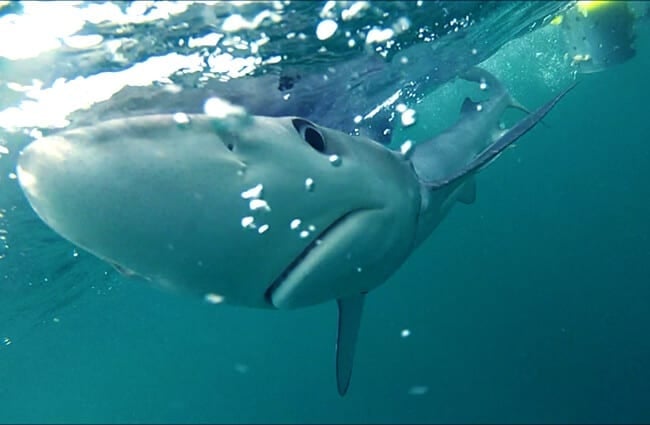The ocean’s vastness holds countless wonders, and among the most captivating is the blue shark. A creature of open water, renowned for its striking coloration and graceful movements, the blue shark Prionace glauca is a truly remarkable animal. This article delves into the life history, behavior, and ecological role of this fascinating species, offering insights for students, animal enthusiasts, and anyone curious about the world beneath the waves.

Understanding the Blue Shark
Blue sharks are oceanic, pelagic sharks, meaning they primarily inhabit the open ocean rather than coastal waters. They are slender in build, with a distinctive deep blue coloration on their dorsal side that fades to bright blue on their flanks and white underneath, a classic example of countershading. This coloration provides camouflage, making them harder to spot from above or below in the open ocean. Adults typically range in length from 6 to 10 feet and can weigh between 130 and 200 pounds, though larger individuals have been recorded. They are found in temperate and subtropical waters worldwide, frequently venturing into deeper, colder waters.
Habitat and Distribution
Blue sharks have a global distribution, found in oceans across the world from as far north as Norway and Iceland to as far south as South Africa and Australia. They are highly migratory, traveling long distances in search of food and suitable breeding grounds. They are often found in areas with strong currents and upwelling, which bring nutrient rich water to the surface, attracting prey. While they do occasionally venture into shallower coastal waters, they are most commonly observed in the open ocean at depths of between 150 and 390 feet, though they can dive much deeper.
Evolutionary History
The evolutionary history of blue sharks traces back to the Lamniformes order, a group of mackerel sharks that emerged during the Cretaceous period, over 100 million years ago. Fossil evidence suggests that early shark ancestors exhibited characteristics similar to modern sharks, including streamlined bodies and cartilaginous skeletons. The blue shark, specifically, is believed to have diverged from other mackerel sharks several million years ago, adapting to a pelagic lifestyle and developing its distinctive blue coloration. Studying the genetic makeup of blue sharks provides insights into their evolutionary relationships and adaptations.
Diet and Feeding Behavior
Blue sharks are opportunistic predators with a varied diet. Their primary food sources include small schooling fish such as herring and mackerel, squid, crustaceans, and occasionally seabirds or marine mammals. They are known to feed on jellyfish, demonstrating their ability to consume a wide range of prey items. Their hunting strategy involves ambushing prey from below, utilizing their speed and agility to capture their meals. They’ve also been observed scavenging on carcasses, playing a role in nutrient cycling in the marine environment.

Ecological Role and Interactions
As important predators, blue sharks play a crucial role in maintaining the balance of marine ecosystems. By controlling populations of smaller fish and invertebrates, they prevent any single species from dominating and disrupting the food web. They interact with other marine animals in various ways, sometimes competing for prey with other sharks or tuna. They also serve as prey for larger sharks, such as great white sharks, and occasionally orcas. Their presence indicates a healthy and functioning marine environment.
Reproduction and Life Cycle
Blue sharks exhibit a unique reproductive strategy known as ovoviviparity. This means that the eggs develop inside the mother’s uterus, and the embryos are nourished by yolk sacs. The gestation period is estimated to be around nine to eighteen months, resulting in litters of typically four to fifty pups. Pups are born alive and are relatively independent from birth, receiving no parental care. They reach sexual maturity at around five to seven years of age. The slow reproductive rate makes them vulnerable to overfishing and habitat degradation.
Mating Rituals and Behavior
Mating rituals in blue sharks are not well documented, but it’s believed that males use visual displays and physical contact to attract females. Pre mating behaviors may include following and circling the female. Males will often bite the female’s pectoral fins to secure their position during mating. The scars from these bites can be observed on female blue sharks. After mating, the female stores the sperm until fertilization occurs.
Blue Sharks and Humans
Historically, blue sharks were often considered a nuisance to fisheries due to their tendency to take bait. Today, they are targeted in some fisheries for their meat, fins, and liver oil. They are also susceptible to bycatch in fisheries targeting other species, such as tuna and swordfish. The International Union for Conservation of Nature (IUCN) lists blue sharks as Vulnerable due to overfishing, bycatch, and habitat loss. Conservation efforts, such as implementing sustainable fishing practices and protecting critical habitats, are essential to ensure their long term survival.

Encountering a Blue Shark in the Wild
While blue sharks are not typically aggressive towards humans, it’s important to exercise caution when encountering them in the wild. If you are diving or snorkeling and encounter a blue shark, maintain eye contact, remain calm, and avoid sudden movements. Do not attempt to touch or feed the shark. If a shark approaches you, slowly back away while maintaining eye contact. Most encounters with blue sharks are harmless, but it’s always best to be prepared and respectful of these magnificent creatures.
Caring for Blue Sharks in Captivity
Blue sharks are rarely kept in captivity due to their size and pelagic nature. Maintaining them in captivity is challenging. Large, deep tanks with strong currents are essential to provide a suitable habitat. They require a diet of fresh or frozen fish and invertebrates. Water quality must be carefully monitored and maintained to prevent disease. Providing enrichment activities, such as introducing new objects or simulating hunting scenarios, is crucial to promote their physical and mental well being. Minimizing stress and providing a stimulating environment are key to ensuring their health and survival in captivity.
Fascinating Facts about Blue Sharks
- Blue sharks can live for over 20 years in the wild.
- They are one of the most widely distributed shark species in the world.
- They can swim at speeds of up to 25 miles per hour.
- They are known to form large schools, sometimes numbering in the hundreds.
- The blue shark’s teeth are small and slender, perfectly adapted for grasping slippery fish and squid.
The blue shark is a testament to the ocean’s incredible biodiversity. Its graceful movements, striking coloration, and vital role in marine ecosystems make it a truly remarkable species. By understanding its life history and ecological importance, we can work towards ensuring its survival for generations to come.

![Red Angus Closeup of a beautiful Red Angus cowPhoto by: U.S. Department of Agriculture [pubic domain]https://creativecommons.org/licenses/by/2.0/](https://animals.net/wp-content/uploads/2020/03/Red-Angus-4-238x178.jpg)




![Red Angus Closeup of a beautiful Red Angus cowPhoto by: U.S. Department of Agriculture [pubic domain]https://creativecommons.org/licenses/by/2.0/](https://animals.net/wp-content/uploads/2020/03/Red-Angus-4-100x75.jpg)

